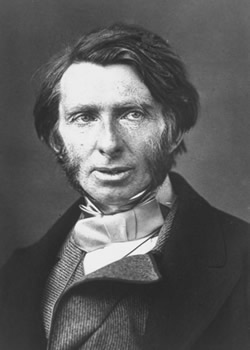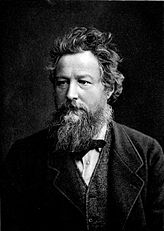Unit 5: Arts and Crafts Movement: Industrialization Presents Challenges and Opportunities
- linabrazile

- Apr 27, 2020
- 4 min read
Updated: May 3, 2020

Queen Victoria, Ruler of England
Period of Reign 1837-1901

Most famous person in the world; colonized many territories outside of the United Kingdom-Hong Kong, Australia, New Zealand. Her favorite title, "Empress of India."
"Victorian" mostly references late
19th century
o featured Greek and Gothic revivalism, Italianate
o interiors were decorated in multiple ways

The Awakening Conscience
William Holman Hunt
1854
Pre Raphaelite painter who commentated on the socially unacceptable-morally repugnancy at the time.
Painting showcases a mid-century 19th century interior. Shows the advancement of the rising middle class, as a result of industrialization. The middle class can now afford a piano, wallpaper, gilded mirror, as showcased in this painting.
Painting captures the attention of John Ruskin, -recognized the moral dishonestly
-observed furniture is cheaply produced
-goes on to state craftmanship is elegant; the pieces created by machines shouldn't be celebrated
John Ruskin - Pioneer of Modern Architecture/Inspired the Arts and Crafts Movement
William Morris - Father of the Arts & Crafts Movement
https://williammorrissociety.org/about-william-morris/ (right)
Artist, critic, pundit on aesthetics & ethics, thinker, seer, this social revolutionary challenged the moral foundations of Victorian Britain. John Ruskin believed in the power of art through craftmanship not the machine to transform the lives of people oppressed more by visual illiteracy than by poor material conditions. His passionate desire was to open people’s eyes to the free beauties surrounding them – sunsets, tender dawn light, iridescent feathers, spectacular natural crystals, green leaves against blue sky, clouds, the vitality of Gothic architecture and ornament. His creed was: ‘There is no wealth but life.’ -John Ruskin Museum
William Morris would become one of the most significant figures in the arts and crafts movement, a man of far ranging creativity and knowledge. His friend Philip Webb designed Morris a family home, Red House in Kent, where the latter lived from 1859 to 1865, before relocating to Bloomsbury, central London. Morris founded his firm Morris, Marshall, Faulkner & Co in 1861 with Burne-Jones, Rossetti, Webb, and others. They were a group of like-minded artists and craftsmen responding to the shoddy practises of much of the Victorian manufacturing. The firm fast became highly fashionable and much in demand, and it profoundly influenced interior decoration throughout the Victorian period, with Morris designing tapestries, wallpaper, fabrics, furniture, and stained glass windows. In 1875, Morris assumed total control of the company, which was renamed Morris & Co and it subsequently traded until 1940, its longevity a testament to the success of Morris’s designs,

This blog highlights a few Victorian period style interiors and furnishings that were mass produced through industralization...compared to those of the Arts and Craft Movement. Enjoy!
Industrially Manufactured during the"Victorian" Era

The Victoria and Albert Museum London
View of the Thonet portal, showing armchair model no. 1 and two examples of side chair no. 14 (entire and dismantled), all Vienna, designed about 1859. Steam-bent, solid and laminated beechwood, with caned seat.
Punctuating the making displays, smaller portals address the careers of eight named designers, including Thomas Chippendale, Michael Thonet (Fig. 5), Frank Lloyd Wright, and the Orkney chair maker David Kirkness, whose workshop exported thousands of straw-back chairs before and after 1900. Whereas so much pre-1900 furniture is anonymous, these offer a personified perspective on the history of furniture making, by considering the particular skills of the makers, and showing how their ideas developed, were realized, and marketed.
Hand-made during the Arts & Crafts Movement

The Victoria and Albert Museum London
Rush Seat Sussex Chair
Place of origin: London (made)
Date: 1870-1890 (made) ca. 1860 (designed)
Artist/Maker: Webb, Philip Speakman Morris & Co. (maker)
Materials and Techniques: Ebonised beech, with a rush seat
This chair was named after a country chair found in Sussex, which inspired the design with the turned frame and rush seat. Similar types of chairs, with imitation bamboo frames and rush seats, were fashionable between 1790 and 1820.
William Morris and his wife, Jane, used Sussex chairs in their first home, Red House, Bexleyheath, Kent, from 1860 and subsequently in their London house, Kelmscott House, Hammersmith. Morris's great friend, the artist Edward Burne-Jones had Sussex armchairs in his studio, as did the sculptor, Alfred Gilbert . Robert Edis recommended this chair as 'excellent, comfortable and artistic' in his influential book, 'Decoration and Furnishing of Town Houses in 1881'. Examples from the Sussex range were supplied for students' rooms at Newnham College, Cambridge, and for galleries in the Fitzwilliam Museum, Cambridge.
Arts & Craft Interior - Charleston Farmhouse, Sussex

https://www.facebook.com/AnnieSloanHome/photos/a.245459100304/10160759026855305/?type=1&theater
Decoration of Charleston Farmhouse, Sussex, 1920s. Wall screens, cupboards and even the log-box were pained by artistans. If you’ve picked up a copy of The Colourist, you’ll already be well aware of this incredible space. A gem of Interior Design inspiration in Sussex, England, Charleston was the rural retreat of the Bloomsbury set and frequently played host to luminaries such as Virginia Woolf and E.M Forster. The primary occupants were Vanessa Bell, Clive Bell, and Duncan Grant who between them spent 65 years transforming a run-down farmhouse into a living tribute to furniture painting, interior arts and self-expression. Words cannot express how much I love this place.
-AnnieSloanHome
Photo credit: Gavin Kingcome. All images credited to Gavin Kingcome are extracted from Charleston: A Bloomsbury House and Garden, by Quentin Bell & Virginia Nicholson. Published by White Lion Publishing.
Evidence of Industrial Pieces in this Interior - Chelsea Hotel, New York City

Hotel Chelsea, built 1883–1885 and designed by Hubert, Pirsson & Co., was New York's first cooperative apartment complex and was the tallest building in the city until 1902. After the theater district migrated uptown and the neighborhood became commercialized, the residential building folded and in 1905 it was turned into a hotel. Ms. Lipschutz’s living room is a riot of American Aesthetic Movement wallpapers. Her store, Secondhand Rose, is famous for its vintage papers and was once as much of a Manhattan institution as the Chelsea Hotel. The gilded red tapestried chair is from Mar-A-Lago in Palm Beach, Florida. Hanging from the bedroom doorway are French Art Nouveau brocade damask portière







Comments